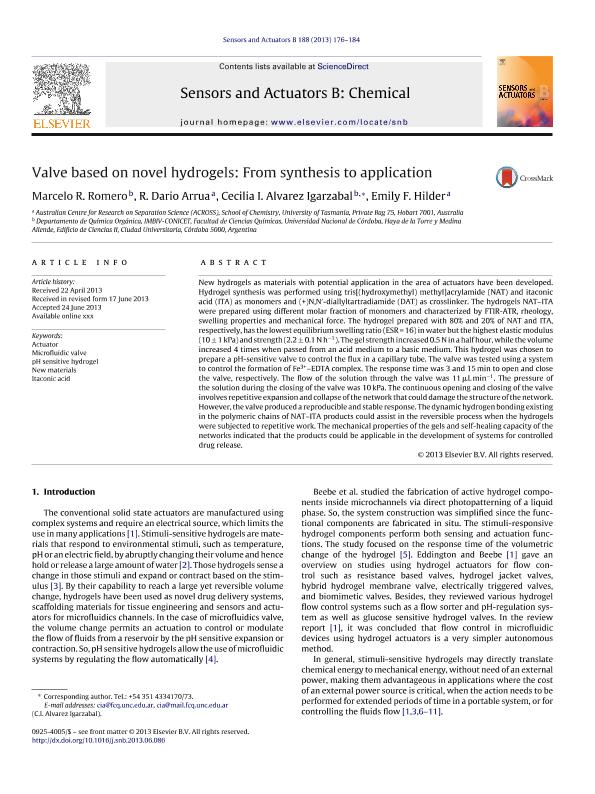Mostrar el registro sencillo del ítem
dc.contributor.author
Romero, Marcelo Ricardo

dc.contributor.author
Arrua, Ruben Dario

dc.contributor.author
Alvarez Igarzabal, Cecilia Ines

dc.contributor.author
Emily Hilder, Emily
dc.date.available
2016-12-28T18:06:13Z
dc.date.issued
2013-11
dc.identifier.citation
Romero, Marcelo Ricardo; Arrua, Ruben Dario; Alvarez Igarzabal, Cecilia Ines; Emily Hilder, Emily; Valve based on novel hydrogels: From synthesis to application; Elsevier Science Sa; Sensors And Actuators B: Chemical; 188; 11-2013; 176-184
dc.identifier.issn
0925-4005
dc.identifier.uri
http://hdl.handle.net/11336/10515
dc.description.abstract
New hydrogels as materials with potential application in the area of actuators have been developed.Hydrogel synthesis was performed using tris[(hydroxymethyl) methyl]acrylamide (NAT) and itaconicacid (ITA) as monomers and (+)N,N-diallyltartradiamide (DAT) as crosslinker. The hydrogels NAT ITAwere prepared using different molar fraction of monomers and characterized by FTIR-ATR, rheology,swelling properties and mechanical force. The hydrogel prepared with 80% and 20% of NAT and ITA,respectively, has the lowest equilibrium swelling ratio (ESR = 16) in water but the highest elastic modulus(10 ± 1 kPa) and strength (2.2 ± 0.1 N by h). The gel strength increased 0.5 N in a half hour, while the volumeincreased 4 times when passed from an acid medium to a basic medium. This hydrogel was chosen toprepare a pH-sensitive valve to control the flux in a capillary tube. The valve was tested using a systemto control the formation of Fe3+EDTA complex. The response time was 3 and 15 min to open and closethe valve, respectively. The flow of the solution through the valve was 11 L by min. The pressure ofthe solution during the closing of the valve was 10 kPa. The continuous opening and closing of the valveinvolves repetitive expansion and collapse of the network that could damage the structure of the network.However, the valve produced a reproducible and stable response. The dynamic hydrogen bonding existingin the polymeric chains of NAT ITA products could assist in the reversible process when the hydrogelswere subjected to repetitive work. The mechanical properties of the gels and self-healing capacity of thenetworks indicated that the products could be applicable in the development of systems for controlleddrug release.
dc.format
application/pdf
dc.language.iso
eng
dc.publisher
Elsevier Science Sa

dc.rights
info:eu-repo/semantics/openAccess
dc.rights.uri
https://creativecommons.org/licenses/by-nc-nd/2.5/ar/
dc.subject
Actuator
dc.subject
Microfluidic Valve
dc.subject
Ph Sensitive Hydrogel
dc.subject
New Materials
dc.subject.classification
Físico-Química, Ciencia de los Polímeros, Electroquímica

dc.subject.classification
Ciencias Químicas

dc.subject.classification
CIENCIAS NATURALES Y EXACTAS

dc.title
Valve based on novel hydrogels: From synthesis to application
dc.type
info:eu-repo/semantics/article
dc.type
info:ar-repo/semantics/artículo
dc.type
info:eu-repo/semantics/publishedVersion
dc.date.updated
2016-12-12T14:15:59Z
dc.journal.volume
188
dc.journal.pagination
176-184
dc.journal.pais
Países Bajos

dc.journal.ciudad
Amsterdam
dc.description.fil
Fil: Romero, Marcelo Ricardo. Consejo Nacional de Investigaciones Científicas y Técnicas. Centro Científico Tecnológico Córdoba. Instituto Multidisciplinario de Biología Vegetal (p); Argentina
dc.description.fil
Fil: Arrua, Ruben Dario. University Of Tasmania. Faculty Of Science, Engineering & Technology. Departament Of Science; Australia
dc.description.fil
Fil: Alvarez Igarzabal, Cecilia Ines. Consejo Nacional de Investigaciones Científicas y Técnicas. Centro Científico Tecnológico Córdoba. Instituto Multidisciplinario de Biología Vegetal (p); Argentina
dc.description.fil
Fil: Emily Hilder, Emily. University Of Tasmania; Australia
dc.journal.title
Sensors And Actuators B: Chemical

dc.relation.alternativeid
info:eu-repo/semantics/altIdentifier/doi/http://dx.doi.org/10.1016/j.snb.2013.06.086
dc.relation.alternativeid
info:eu-repo/semantics/altIdentifier/url/http://www.sciencedirect.com/science/article/pii/S0925400513007776
Archivos asociados
